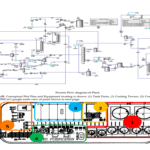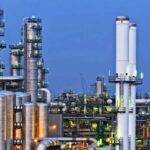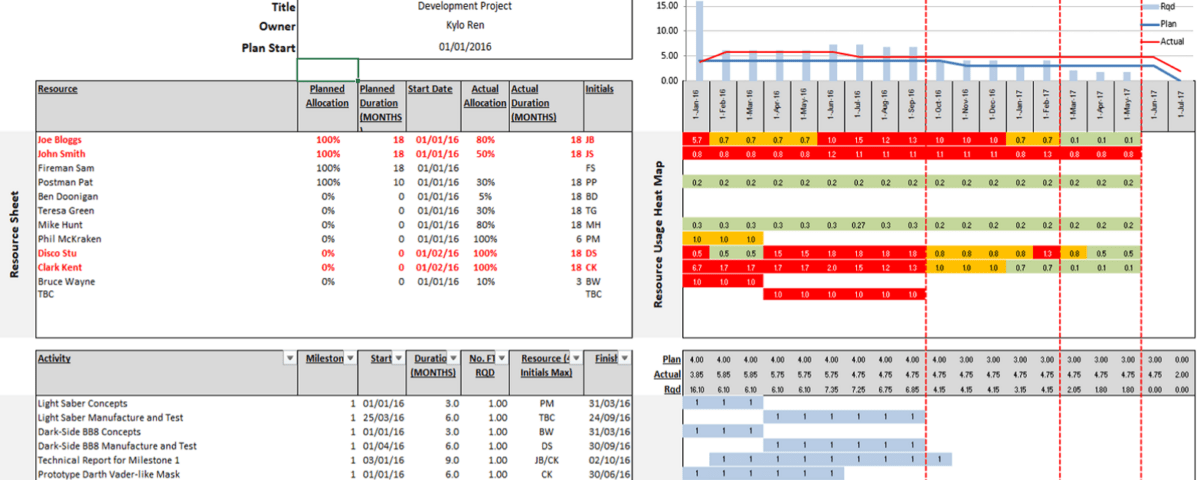Introduction
The MRP.xlsx file is designed as a key resource for analyzing the performance of the Arta Chemistry manufacturing plant, containing comprehensive and detailed information across various operational areas. The reports are categorized into main components including production efficiency and scheduling, input materials, output product specifications, workforce statistics, and purchased and consumed raw material tonnage. In the efficiency and scheduling section, productivity percentages and working hours of production lines are clearly displayed to help identify strengths and weaknesses in the processes.
Additionally, information regarding input materials, particularly the concentration and amount of NaOH, aids in the optimal management of raw materials. The specifications of the final product and workforce statistics, including the number of employees and paid wages, reflect the human and economic aspects of production. Overall, this file can significantly improve decision-making and managerial strategies at Arta Chemistry.
Keys to Success in Sustainable Organizational Management: Strengthening Production, Workforce, and Social Responsibility
In today’s industrial world, the success of organizations increasingly depends on their ability to manage production processes, workforce, and raw material supply effectively and sustainably. The importance of these topics is such that organizations cannot simply overlook them, as their efficient and profitable performance is influenced by smart and strategic decision-making in these areas. Given the challenges present in the marketplace, including changing customer demands, financial pressures, and increased competition, organizations must focus on improving production management, workforce analysis, optimizing raw material supply, considering environmental impacts and social responsibility, and developing sustainable strategies.
Attention to production management not only enhances productivity and product quality but also reduces costs and increases overall organizational efficiency. On the other hand, thorough analysis of the workforce can lead to the creation of a positive workplace culture which is vital for increasing employee productivity and job satisfaction. Additionally, optimizing raw material supply can prevent inefficiencies and contribute to lower operational costs.
In this context, attention to environmental impacts and social responsibility as a core principle of sustainable strategies not only aids business success but also enhances brand image and increases customer loyalty. In other words, devising sustainable strategies helps institutionalize these principles in organizations so they can operate effectively and sustainably in pursuit of their goals, achieving balanced and sustainable development. Subsequently, we will examine each of these issues in more detail.
Importance of Production Management
Production management, as a fundamental element of industrial processes, involves examining and optimizing production methods and practices, significantly impacting the efficiency and profitability of organizations. Moreover, optimizing production scheduling allows managers to facilitate workflow and minimize downtime. Additionally, coordination and collaboration between various production departments maximize resource use and yield better business results. Therefore, production management not only contributes to improving factory performance but also plays a significant role in maintaining and increasing market competitiveness.
Workforce Analysis and Its Impact on Productivity
Workforce analysis and an accurate understanding of its composition are key components of human resource management and have a substantial impact on organizational productivity. Examining data related to wages and benefits assists in identifying issues affecting employee morale and measuring their job satisfaction levels. When workforce management is conducted intelligently and optimally, it not only leads to increased job satisfaction and reduced turnover rates but also creates an opportunity to foster a positive work culture that enhances collaboration and interaction among teams.
This positive and collaborative environment can strengthen relationships among team members and boost innovation, creativity, and motivation among employees. Additionally, rigorous analyses of individual and team performance allow managers to identify strengths and weaknesses and propose appropriate solutions for continuous improvement. Ultimately, this process increases overall organizational efficiency and helps achieve long-term business goals.
Optimizing Raw Material Supply
Optimizing raw material supply as a critical element in the production process plays a fundamental role in achieving the overall objectives of the organization and requires continuous monitoring and analysis of input and output material flows. By examining the tonnage of consumed materials, managers can plan more effectively for procurement, supply, and storage of materials, thereby preventing issues arising from shortages or excess supply. This optimization not only ensures the continuity of production operations but can also lead to reduced maintenance and storage costs.
Moreover, by utilizing demand forecasting techniques and analyzing market trends, organizations can improve the efficiency of their supply chains and increase their capacity to respond to changing customer needs. Consequently, effective management of raw material supply enables cost reductions and enhances economic returns, which, in turn, can improve the competitiveness of the organization in various markets. Ultimately, this strategy helps organizations not only optimize their resources but also act in favor of the environment, facilitating greater sustainable development.
Environmental Impacts and Social Responsibility
Environmental impacts and social responsibility are key aspects of managing the economic affairs of organizations and cannot be separated from production processes, workforce management, and raw material supply. Today, factories must emphasize adopting sustainable approaches to production and material supply while continuing their efforts to reduce negative environmental impacts. This approach includes a range of measures such as reducing waste, optimizing the use of natural resources, and incorporating green and innovative technologies that can lead to reduced energy and water consumption.
Additionally, implementing responsible practices in supplier selection and evaluating the supply chain contributes to preserving ecosystems and supporting biodiversity. Not only do these initiatives assist in environmental protection, but they also enhance the organization’s brand image, capturing the attention of customers and stakeholders who are conscious of social and environmental issues. In this way, organizations can increase customer loyalty by demonstrating their commitment to social responsibility while also fostering a positive internal culture among their workforce. Ultimately, these actions not only support sustainable profitability for factories but also benefit the surrounding community, aligning with sustainable development.
Developing Sustainable Strategies
Developing sustainable strategies in organizations is recognized as a necessity in today’s era; effectively utilizing data and precise analyses in production, workforce, and raw material supply empowers factories to devise data-driven strategies. These strategies can significantly ensure diversity and innovation in new products while also improving existing business processes. Moreover, investment in new and green technologies not only enhances operational efficiency but also reduces costs and improves product quality.
Ultimately, these strategies fortify the financial and economic foundations of the factory and pave the way for long-term growth and success. By implementing thoroughly examined and data-driven sustainability practices, organizations can achieve greater market competitiveness and sustainable development.
Key Success Factors in Optimizing Production and Increasing Productivity at Arta Chemistry
In the modern industrial landscape, the success and productivity of any factory, including Arta Chemistry, are dependent on a combination of key factors encompassing efficiency, production scheduling, input management, output monitoring, workforce statistics, and material tonnage. Efficiency and production scheduling, as two essential components, directly impact the factory’s performance and profitability. By improving these aspects, weaknesses can be identified, and operational costs can be reduced.
Moreover, input materials play a significant role in the final product’s quality, and with careful control and analysis, optimization of raw material consumption and enhancement of product quality can be achieved. The output product itself must be produced according to specific quality standards to easily gain customer satisfaction and enhance brand credibility.
Workforce statistics and wage assessments aid in understanding and enhancing the factory’s human resources, leading to improved job satisfaction and productivity. Finally, analyzing material tonnage and its optimal management enables the factory to fine-tune production schedules effectively and avoid resource waste.
Efficiency and Production Scheduling
Efficiency and production scheduling are key factors in optimizing industrial processes and increasing profitability in any manufacturing facility, including Arta Chemistry. These two elements directly influence production performance and analysis. By measuring efficiency percentages, managers can identify the strengths and weaknesses of production lines and schedule necessary improvements. Conversely, production scheduling refers to managing various times in the production process to ensure that each stage occurs at the right time and without interruptions. Accurate scheduling can aid in designing efficient production plans and optimal allocation of human resources and raw materials while preventing delays in production lines.
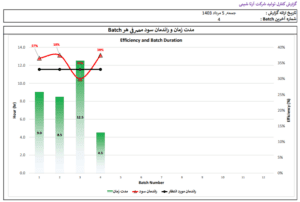
For instance, if scheduling is not correctly set, the production process may face delays, leading to increased operational costs and potentially impacting product quality. Therefore, measuring and analyzing efficiency and scheduling should be continuously performed to identify and rectify errors. One useful metric in this context involves identifying factors contributing to production bottlenecks, which may stem from technical issues, workforce shortages, or delays in material supply. By relying on existing data in this area, Arta Chemistry can make strategic decisions that lead to reduced costs and increased production capacity.
Input Materials
Input materials are a vital component of every production process, directly affecting quality and production efficiency. In the MRP.xlsx file, data related to input materials, including NaOH concentration and the amount of input per batch, are recorded with precision. This data can serve as an effective analytical tool for managers at Arta Chemistry, enabling them to monitor and analyze this information to optimize raw material consumption. For example, if NaOH concentration is carefully controlled, it can prevent overuse and material waste, ultimately leading to reduced costs and extended raw material lifespan.
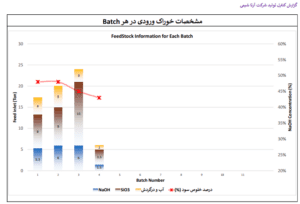
Furthermore, thorough evaluation of input materials not only aids in optimizing consumption but can also positively impact the quality of final products. The best control over the quality of raw materials contributes to the production of higher-quality products and adherence to desired standards. In other words, if raw materials are supplied with precision and quality, it will result in a significant improvement in the production process and ultimately customer satisfaction. Analysis of input materials can also help identify consumption patterns and determine optimization trends over time, potentially leading to a competitive edge in the market. Consequently, comprehensive attention to input materials and their management not only leads to improved product quality but can also yield positive effects on profitability and overall factory performance.
Output Product
The output product is one of the key components in evaluating the performance and success of any manufacturing plant, and this section addresses the specifications of the final products at Arta Chemistry. This information encompasses density, production volume, and other properties of various products. Density, as a physical property of products, provides important information regarding the quality and applicability of products in various industries. By accurately measuring and analyzing these values, managers can identify the strengths and weaknesses of each product and make necessary decisions for enhancing quality and efficiency.
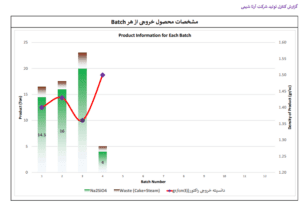
A detailed examination of this information not only aids in determining the quality and performance of each product but can also lead to identifying market consumption trends and needs. Consequently, the factory can adapt its products according to customer demand and market fluctuations, thus preventing resource waste and inappropriate product production.
Ultimately, data regarding output products can contribute to branding and increasing the factory’s credibility. When high-quality products with precise specifications are introduced to the market, it not only increases customer satisfaction but can also attract new customers and elevate the factory’s brand name. Therefore, attention to output product details and ongoing evaluation are vital for maintaining and enhancing Arta Chemistry’s competitive position in the market.
Workforce Statistics and Wages
Workforce statistics and wages are one of the most important parts of any factory or organization, profoundly influencing overall performance. In this section, data related to the number of employees, their roles and responsibilities, and the wages and benefits paid to them are recorded and analyzed. This data allows management to closely monitor human resource costs and identify the strengths and weaknesses of the workforce. For instance, management can determine whether the employee-to-production ratio is optimal and, if necessary, make adjustments in staffing or work methods.
Another crucial point is that analyzing workforce data helps improve employee job satisfaction and productivity. By reviewing wages and benefits, as well as working conditions, management can prevent potential employee dissatisfaction and create a better work environment. Attention to the workforce can also contribute to reducing employee turnover, which in itself can save on recruitment and retraining costs.
Furthermore, by identifying work patterns and efficiencies, management can develop appropriate training and development programs to enhance employee skills. Overall, this area of information can provide key patterns for managers’ strategic decision-making, which directly impacts the success and growth of the organization.
Material Tonnage
Material tonnage, as a vital aspect of production management and resource supply in any factory, involves analyzing and reviewing reports related to purchasing and consumption of raw materials, including silica and NaOH, as well as production and sales of products. In this section, managers can access precise information regarding the amount of raw materials purchased and consumed, identify fluctuations in production and sales, and assess future needs. This data allows them to make better decisions regarding the supply and storage of raw materials, ultimately leading to optimal management of the production process.
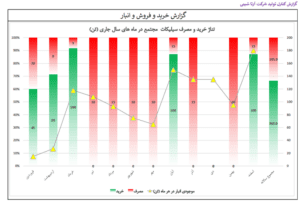
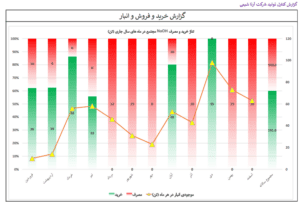
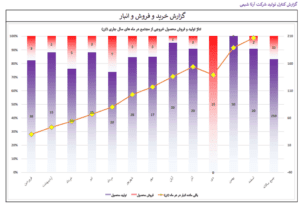
Moreover, analyzing material tonnage can greatly aid in reducing waste. Furthermore, this analysis can assist in optimizing production management and related scheduling, ensuring that factories do not face shortages or excess production.
Ultimately, data regarding material tonnage serves as a strategic tool in the organization’s macro and mid-term decision-making. By identifying trends and forecasting future needs, managers can act to secure raw materials and achieve overall improvements in factory efficiency and productivity. This approach not only aids in enhancing the quality of final products but also increases customer satisfaction and realizes the organization’s business goals. Consequently, attention to material tonnage and its optimal management becomes one of the key factors in the broad and sustainable success of the factory.
Conclusion
The examination and analysis of information related to production, workforce, and material tonnage at Arta Chemistry indicate that effective management of these data can lead to the overall improvement of organizational performance and increased profitability. By accurately identifying output product specifications, managers will be able to optimize product quality and configure production processes more efficiently.
Furthermore, the analysis of material tonnage assists managers in optimizing raw material supply and enables better future planning, reducing waste in the process. In totality, these three key elements—product specifications, workforce, and material tonnage—can collectively present complex strategies for the growth and sustainable development of the factory. Thus, focusing on each of these aspects as part of an integrated system is essential for Arta Chemistry to maintain and enhance its position in today’s competitive market. These analyses and data-driven decision-making not only improve performance and quality but also contribute to customer satisfaction and brand reputation.
To enhance performance and productivity in the design, establishment, production of technical knowledge, innovative engineering, and optimization of glycol production and purification units in Saudi Arabia, Chemengproj Company has undertaken comprehensive simulation and optimization studies on the key processes of this unit. These studies include the following:
1. Feasibility study of the separation and purification unit of glycols with a capacity of 15 KTY.
2. Production of basic engineering documents; Operation Manual for the glycol unit.
3. Performance analysis of production and resource management at the Arta Chemical plant: evaluation of performance reports, human resources, and raw materials.
4. Establishment plan and technical knowledge for producing MEG, DEG, and TEG with a capacity of 15 KTY.
5. Design of documents, technical knowledge, and drawings for BFD, PFD, PID, and UFD of the glycol purification unit.
6. Management, control, and endorsement of engineering documents for the production unit of MEG, DEG, and TEG.
7. Simulation and optimization of the Monoethylene Glycol (MEG) purification process with a production capacity of 10 KTY.
8. Simulation and optimization of the Monoethylene Glycol (MEG) purification process with a production capacity of 15 KTY.
These actions aim to enhance the production of modern technical know-how and engineering, reduce production costs, optimize ethylene glycol production processes, and design updated units. The ultimate goal is to ensure better product quality and increase the company’s competitiveness in the market.
Performance Analysis of Production and Resource Management at Arta Chemistry: Evaluation of Performance Reports, Human Resources, and Raw Materials
In this project, an analysis of production performance and resource management at Arta Chemistry has been conducted: evaluating performance reports, human resources, and raw materials.
